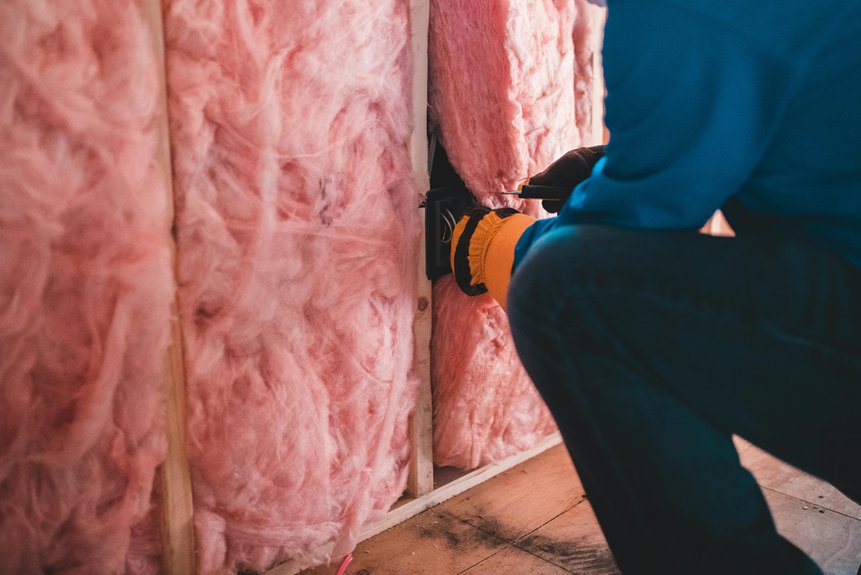Rolled insulation is available in a variety of types, including fibreglass, mineral wool, and cellulose, each providing distinct advantages such as fire resistance or eco-friendliness. Choosing the appropriate size and R-value is crucial, taking into account the UK climate and building regulations to ensure effective thermal performance.
The installation process is relatively straightforward. It involves unrolling the insulation between studs or joists, ensuring it is securely fastened to prevent any gaps. When properly installed, rolled insulation enhances energy efficiency and comfort within the home.
For those looking to optimise their insulation choices, continued exploration into the specific benefits and applications of these materials can provide valuable insights.
Types and Materials of Rolled Insulation
Rolled insulation is available in a variety of types, each crafted from different materials to address specific requirements and environments.
Fibreglass insulation is lightweight and durable, woven from fine glass fibres, and offers notable thermal resistance. It’s commonly employed in DIY projects, used within walls, floors, and ceilings.
However, care should be taken when handling it, as it can cause skin and respiratory irritation.
Mineral wool, also known as rockwool, is composed of stone or slag fibres, providing excellent fire resistance and soundproofing. Its snug fit helps to minimise air gaps, making it an effective choice for energy efficiency.
Cellulose insulation, made from recycled paper, is dense and environmentally friendly. It boasts high thermal performance and good fire resistance, as well as natural resistance to fungi.
Reflective foil-backed rolls are designed to reflect radiant heat, making them particularly suitable for attics.
Additionally, recycled cotton or polyester options are eco-conscious, allowing for safe, itch-free handling while delivering commendable thermal and acoustic performance. Manufacturers also produce specialized foil-backed rolls that further enhance heat reflection, optimizing insulation efficiency.
Selecting the Right Size and R-Value
How do you select the appropriate size and R-value for insulation?
First, consider the climate zone and building regulations. Different regions necessitate varying R-values; for instance, colder climates often require higher standards in attics, while walls may call for moderate levels of insulation. Proper sizing is crucial to ensure effective coverage and performance, as using insulation that is too small or too large can diminish its insulating properties. The R-value indicates insulation’s resistance to heat flow—higher numbers signify superior insulation performance.
Ensure you match this to the specific application, such as insulation suitable for attics or walls in typical homes. Insulation is available in an array of sizes, with roll widths ranging from 15 to 72 inches and thicknesses reaching up to 9.5 inches.
Carefully selecting the right size and R-value is essential for energy efficiency and adherence to local guidelines, contributing to a comfortable and cost-effective living environment for all.
Installation and Performance Benefits
Installing roll insulation offers numerous advantages, particularly in terms of speed and ease when covering expansive areas. Its long lengths, typically ranging from 20 to 40 feet, enable installers to efficiently cover large spaces such as ceilings or walls.
The installation process involves unrolling the material between studs or joists and securing it with staples or adhesive, making it a straightforward task.
The benefits of roll insulation include:
- High thermal resistance when installed correctly, contributing to reduced energy costs.
- A continuous form that minimises gaps, which can lead to air leakage.
- While the material is easy to cut and fit, careful handling is essential to prevent tearing or compression, ensuring its effectiveness is maintained.
Conclusion
Rolled insulation provides effective thermal protection, available in a variety of materials and sizes to meet diverse requirements. Selecting the appropriate R-value is crucial for ensuring optimal energy efficiency, while proper installation enhances overall performance.
Understanding these aspects enables homeowners to make informed choices, ultimately improving comfort and reducing energy expenses. With the right knowledge, the process of selecting and installing rolled insulation becomes straightforward, making it an excellent option for enhancing home insulation.
In summary, the right choice of rolled insulation can significantly enhance a building’s energy efficiency and comfort, contributing to a more sustainable living environment.

